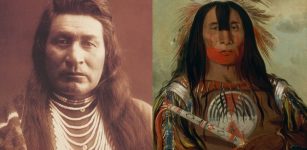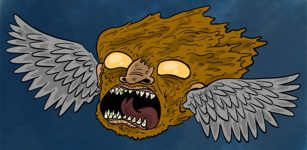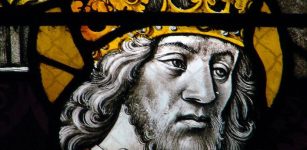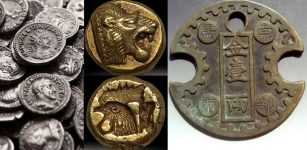Monumental Totem Poles Of Native American People Tell Stories Of Ancestors
A. Sutherland - AncientPages.com - The indigenous peoples of the Pacific Northwest Coast have a very complex kinship structure, demonstrated in many carvings on totem poles.
 A Gitxsan pole (left) and Kwakwaka'wakw pole (right) at Thunderbird Park in Victoria, Canada. IMage credit: H at English Wikipedia - Public Domain; Right: Totem pole in Vancouver, British Columbia. Image credit: Mitzi.humphrey - CC BY-SA 4.0
A Gitxsan pole (left) and Kwakwaka'wakw pole (right) at Thunderbird Park in Victoria, Canada. IMage credit: H at English Wikipedia - Public Domain; Right: Totem pole in Vancouver, British Columbia. Image credit: Mitzi.humphrey - CC BY-SA 4.0
The word 'totem' is derived from the Ojibwe (Chippewa) word 'odoodem' meaning "his kinship group."
Carvings on the totem poles included birds, fish, animals, insects, plants, and humans, but also other animals – shapeshifters - that could transform themselves into another form and supernatural beings such as the Thunderbird, which the Gods sent to protect humans from evil.
Thunderbird, a mighty and gigantic creature, is one of the most powerful of all spirits, and it can be seen on many poles. This creature is often carved with outstretched or uplifted enormous wings atop many totem poles but not all.
Thunderbird is known to suddenly swoop down from the sky to capture a whale in its strong talons; then, it flies off to the mountains to eat it. The bird's blinking eyes send lightning flashes, and thunder rolls from its wing beat.
The Haida often place three guards on top of their totems. The old Haida villages were always guarded against attack by a watchman, distinguished by wearing a conical-shaped hat made from cedar bark.
 Detail of a totem pole. Image credit: Jerzy Strzelecki - CC BY-SA 3.0
Detail of a totem pole. Image credit: Jerzy Strzelecki - CC BY-SA 3.0
Many Haida totems (even contemporary ones) are topped with carved watchmen who stand guard.
Totem poles had never been religious objects of worship but a way to express a family's pride, ancestry, and social rank or pass down myths of great importance to future generations.
The animals, beings, and symbols carved on totem poles were symbols of tribe, family, clan, or a person.
They also had a mythological significance as representations of the "World Tree," a pole that holds up the sky."
An interesting pole was the so-called "shame pole," carved for a chief who wanted to ridicule or shame another person, usually his rival. The shame pole stood in a public place and functioned as a form of public ridicule. When restitution was made, the carving came down.
The tradition of the totem poles extended from the southeast corners of Alaska southward through the Canadian coastal province of British Columbia. It even reached Puget Sound, located in Western Washington State.
The totem poles could be read like a book, full of history and legends of tribes, continuously passed on from one generation to another. These stories involved animals, birds, and symbols.
Some told of events that happened to a clan; others were devoted to the history of a family. The tradition of mortuary poles for people of high rank, usually carved with crests of the deceased, was practiced by the Tlingit and Haida tribes.
The Native Americans of the northwest coast have a very complex kinship structure, which is demonstrated in many of the carvings on totem poles.
 Totem poles in Stanley Park, Vancouver. Image credit: Hans-Peter Eckhardt - CC BY-SA 2.0 de
Totem poles in Stanley Park, Vancouver. Image credit: Hans-Peter Eckhardt - CC BY-SA 2.0 de
Native Americans considered it a great honor to possess a totem pole. The important families of the tribe were divided into totemic groups with different house totem poles.
According to Native Americans' beliefs, a person is associated with an 'animal guide' that gives wisdom, guides a person spiritually and physically, and helps make important life decisions. People named themselves after an ancestor in one of the hero legends who had a special relationship with an animal carved on the totem.
For example, there were Bear people with bear symbols on their houses and clothing, and several others like Cannibal Spirit, Beaver, Killer Whale, and Salmon.
People carved the totem poles out of gigantic red cedar trees ("Thuja plicata "), mainly on North America's Pacific Northwest Coast. Sometimes, the totem poles were even 60 feet high and could take up to three years to carve and paint in black, red, blue, green, and white colors made from a mixture of clay, copper, berries, shells, and bark.
The totem poles were historical monuments with significant social meaning. They preserved ancient customs and helped to keep the memory of the old stories and old beliefs. They have long held the tradition of the Native American tribes - alive.
Written by – A. Sutherland AncientPages.com Staff Writer
Updated on October 7, 2022
Copyright © AncientPages.com All rights reserved. This material may not be published, broadcast, rewritten or redistributed in whole or part without the express written permission of AncientPages.com
Expand for referencesReferences:
Malin, E. Totem Poles of the Pacific Northwest Coast
Stewart, H. Looking at Totem Poles
Pat Kramer, Alaska's Totem Poles
More From Ancient Pages
-
 Why Do Native Americans Often Wear Long Hair?
Ancient History Facts | Sep 19, 2019
Why Do Native Americans Often Wear Long Hair?
Ancient History Facts | Sep 19, 2019 -
 Scientists Argue Over The Mysterious Void Discovered Inside The Great Pyramid Of Giza
Archaeology | Nov 8, 2017
Scientists Argue Over The Mysterious Void Discovered Inside The Great Pyramid Of Giza
Archaeology | Nov 8, 2017 -
 New Evidence Of Human Habitation At Panga ya Saidi Cave, Kenya That Dates Back 78,000 Years
Archaeology | May 11, 2018
New Evidence Of Human Habitation At Panga ya Saidi Cave, Kenya That Dates Back 78,000 Years
Archaeology | May 11, 2018 -
 Mysteries Of The Great Dismal Swamp – Unexplained Vanishings, Bewildering Encounters With Weird Beings, And Scary Legends
Featured Stories | Dec 22, 2024
Mysteries Of The Great Dismal Swamp – Unexplained Vanishings, Bewildering Encounters With Weird Beings, And Scary Legends
Featured Stories | Dec 22, 2024 -
 2000-Year-Old Tomb Discovered In Northwestern China
Archaeology | Dec 7, 2015
2000-Year-Old Tomb Discovered In Northwestern China
Archaeology | Dec 7, 2015 -
 A 19th-Century Sailing Ship Loaded With Champagne, Wine, Porcelain And Mineral Water Found At The Bottom Of The Baltic Sea
Underwater Discoveries | Jul 25, 2024
A 19th-Century Sailing Ship Loaded With Champagne, Wine, Porcelain And Mineral Water Found At The Bottom Of The Baltic Sea
Underwater Discoveries | Jul 25, 2024 -
 Horrifying Flying Head That Terrorized The Iroquois
Featured Stories | Sep 17, 2019
Horrifying Flying Head That Terrorized The Iroquois
Featured Stories | Sep 17, 2019 -
 On This Day In History: Charlemagne King Of The Franks And Emperor Of The Holy Roman Empire Born – On April 2, 742
News | Apr 2, 2017
On This Day In History: Charlemagne King Of The Franks And Emperor Of The Holy Roman Empire Born – On April 2, 742
News | Apr 2, 2017 -
 Silver Offers Evidence Viking Age Started Much Earlier Than Previously Thought – Archaeologist Says
Archaeology | Nov 7, 2023
Silver Offers Evidence Viking Age Started Much Earlier Than Previously Thought – Archaeologist Says
Archaeology | Nov 7, 2023 -
 War God Ares Was Brutal, Merciless And Disliked By Greeks But Popular In His Love Affairs
Featured Stories | Apr 16, 2021
War God Ares Was Brutal, Merciless And Disliked By Greeks But Popular In His Love Affairs
Featured Stories | Apr 16, 2021 -
 Study Sheds Light On Life Beyond Rome’s Frontier
Archaeology | Jun 2, 2022
Study Sheds Light On Life Beyond Rome’s Frontier
Archaeology | Jun 2, 2022 -
 Engraved Trees Are Living Records Capturing The Rich History And Traditions Of The Sámi People
Archaeology | Nov 21, 2024
Engraved Trees Are Living Records Capturing The Rich History And Traditions Of The Sámi People
Archaeology | Nov 21, 2024 -
 Skull From Broken Hill, Zambia Is Relatively Young – New Analysis Shows
Fossils | Apr 2, 2020
Skull From Broken Hill, Zambia Is Relatively Young – New Analysis Shows
Fossils | Apr 2, 2020 -
 Never-Before-Seen Ancient Texts Hidden In Saint Catherine’s Monastery In Sinai Are Now Available Online
Archaeology | Dec 21, 2017
Never-Before-Seen Ancient Texts Hidden In Saint Catherine’s Monastery In Sinai Are Now Available Online
Archaeology | Dec 21, 2017 -
 On This Day In History: Battle Of San Domingo Was Fought – On February 6, 1806
News | Feb 6, 2017
On This Day In History: Battle Of San Domingo Was Fought – On February 6, 1806
News | Feb 6, 2017 -
 Mysterious Old Ship With No Crew Reaches The Canadian Coast
Featured Stories | Jul 25, 2024
Mysterious Old Ship With No Crew Reaches The Canadian Coast
Featured Stories | Jul 25, 2024 -
 Anglo-Saxon Previously Unknown Monastic Or Trading Center – Discovered
Archaeology | Mar 7, 2016
Anglo-Saxon Previously Unknown Monastic Or Trading Center – Discovered
Archaeology | Mar 7, 2016 -
 Ancient Round Coins Were Invented To Prevent Fraud
Ancient History Facts | Mar 21, 2018
Ancient Round Coins Were Invented To Prevent Fraud
Ancient History Facts | Mar 21, 2018 -
 Oldest Living Culture: Research Reveals Indigenous Ritual Spanning 500 Generations
Featured Stories | Jul 9, 2024
Oldest Living Culture: Research Reveals Indigenous Ritual Spanning 500 Generations
Featured Stories | Jul 9, 2024 -
 Cato The Younger – Mortal Enemy Of Julius Caesar Was A Man Who Hated Luxury, New Ideas And Was Immune To Bribes
Featured Stories | Mar 18, 2025
Cato The Younger – Mortal Enemy Of Julius Caesar Was A Man Who Hated Luxury, New Ideas And Was Immune To Bribes
Featured Stories | Mar 18, 2025
